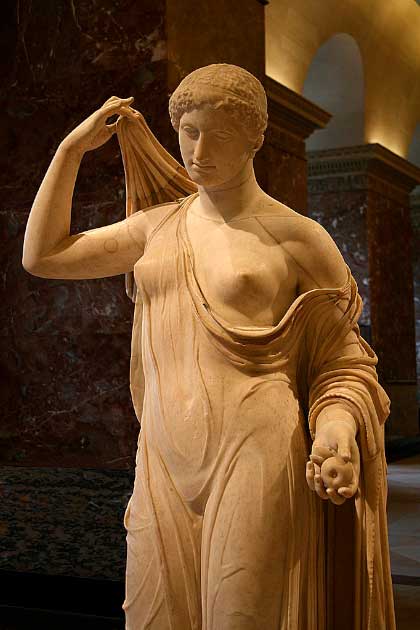Was the “Forbidden Fruit” in the Garden of Eden Actually an Apple?
The forbidden fruit reference in the Bible and the story of how Adam and Eve were kicked out of the Garden of Eden is well known and used in all kinds of modern contexts. But was the forbidden fruit an apple or some other fruit? Why was the apple chosen to represent the forbidden fruit of the Tree of Knowledge of Good and Evil? Here are a few explanations for this ancient and puzzling question.
These words, from Chapter II of The First Book of Moses or Genesis, have become synonymous with the “Forbidden Fruit,” i.e., the apple:
“And the Lord God commanded the man, saying, Of every tree of the garden thou mayest freely eat: But of the tree of the knowledge of good and evil, thou shalt not eat of it: for in the day that thou eatest thereof thou shalt surely die.”
Believe it or not, the apple has been wrongly used as the forbidden fruit in popular theological culture. A cursory reading of the Bible does tell us that Adam and Eve were cast out of the Garden of Eden for not resisting the forbidden fruit, and thereby falling to temptation after the serpent guarding the Tree of Knowledge managed to manipulate Eve to trick Adam. The problem is that the older Hebrew Bible does not specify what fruit the forbidden fruit was, leaving it generic. So, why the apple?

In this painting, The Garden of Eden and the Fall of Man or The Fall of Man painted by Peter Paul Rubens (figures) and Jan Brueghel the Elder (landscape and animals), the forbidden fruit tree bears many different fruits. (Peter Paul Rubens / Public domain)
Unravelling the Forbidden Fruit Apple Motif
In the next chapter of Genesis in the Old Testament, this stanza describes the temptation of Adam and Eve:
"When the woman saw that the tree was good for eating and a delight to the eyes, and that the tree was desirable as a source of wisdom, she took of its fruit and ate. She also gave some to her husband, and he ate.”
These two sentences have been used since they were first written down as a metaphorical reference to any indulgence or pleasure that the dogmas of religion deem illegal or immoral. The Hebrew word used for fruit here is “peri,” a generic term referring to the fruit hanging from the Tree of Knowledge. And they are still heavily referenced today in conversations, novels, and films.
Modern scholars and historians believe that a bastardization and possible misinterpretation of Latin might answer the question, “Why the Apple?” The Latin word mălum signifies “evil,” while the Latin word mālum, from the Greek μῆλον, means “apple.”
- Zeus and Hera – A Match for the First Couple of Genesis?
- Can the Babylonian Calendar Help Explain the Ages of Patriarchs Recounted in the Book of Genesis? - Part 1
The forbidden fruit translation error may have occurred due to an incident in the 4th century AD, when Pope Damasus ordered Jerome, an eminent scholar of scripture, to translate the Hebrew Bible into Latin. This is according to Robert Appelbaum, a professor emeritus of English literature at Uppsala University in Sweden. "The word ["malum"] in Latin translates into a word in English, apple, which also stood for any fruit ... with a core of seeds in the middle and flesh around it. But it was a generic term [for fruit] as well," Appelbaum told Live Science.
The translation, which included the language spoken by the “common man” and commissioned by the Catholic Church, is called Vulgate. As mentioned earlier, “peri” could have been any fruit: a fig, a grape, an apricot, or an orange. Jerome translated peri as malus, which at that time referred to any fleshy, seed-bearing fruit.

A famous Roman statue of Aphrodite with the forbidden fruit in her left hand made with marble from Paros from the imperial period (late 1st century or early 2nd century AD) in the Louvre collection. (Jean-Pol GRANDMONT / CC BY 4.0)
The Apple in Classical Mythology
Despite its facetious Biblical origins, the apple continued to be the forbidden fruit in popular culture with links in other mythology. An apple started the legendary Greek Trojan War myth. In Norse mythology, the gods believed that their immortality was a product of apples. In the Arabian nights, a magical apple from Samarkand cures all human disease, long before the advertising campaign of 1866 told us, “an apple a day keeps a doctor away.”
In ancient Greece, Dionysus, the god of wine and fertility, apparently created the apple, presenting it to Aphrodite, the goddess of love. Thus began a practice of newlyweds in Athens eating an apple, to increase fertility, before entering the bridal chamber.
The most famous apple reference of all would have to be the Golden Apples of the Hesperides, in the private orchard of the goddess Hera. At Zeus and Hera’s wedding, branches with golden apples were the wedding gifts, again linked to sex and fertility.
One of the Twelve Labors of Heracles (Hercules) involved stealing the Golden Apples of Hesperides from Hera’s orchard. This involved tricking Atlas into retrieving the apples for him, whilst Heracles held up the sky in his absence.
The shape of an apple can also be connected with the shape of a woman’s breast, which could be another reason the apple is a fertility symbol and not really forbidden fruit at all if you were getting married or were married.

Adam and Eve by Albrecht Dürer painted in 1507 AD prominently features the forbidden fruit connecting both panels with the snake almost forgotten in the upper righthand corner. (Albrecht Dürer / Public domain)
The Apple in Medieval Europe and Popular Culture
The apple became a big theme in post-classical Western European art and culture by at least the 12th century AD. Renaissance paintings also featured the apple. German artist Albrecht Durer’s famous First Couple engraving of 1504 shows Adam and Eve beside an apple tree. In 1533, Lucas Cranach, borrowing from Durer, depicted a glowing ruby-like apple, with a luminous Adam and Eve in the center, in his painting titled Adam and Eve.
Other major Renaissance artists also used the forbidden fruit theme but chose fruits that were not apples. In Ghent Altarpiece by Hubert and Jan van Eyck, 1432, the fruit was a citron. In Eve Tempted By the Serpent, by Italian Defedente Ferrari in the early 1520s, the fruit was an apricot. And in The Fall of Man by Peter Paul Rubens, 1628-29, it was a pomegranate. Michelangelo's masterpiece, The Sistine Chapel, features a fresco with a serpent coiled around a fig tree.
- "I am the Lord God Dionysus": Parallels between Yahweh and Dionysus
- What Happened in Eden? Alternative Translation Tells a Very Different Story
What sealed the deal for the apple as the forbidden fruit in Western consciousness was English poet John Milton’s seminal work Paradise Lost (1667). In this work Milton used the word “apple” twice to refer to the forbidden fruit. During this voluminous 10,000-line poem, Milton vividly describes the apple "as being fuzzy on the outside, and extremely juicy and sweet and ambrosial,” as Eve takes the mythical bite. In his earlier work from 1644 titled Areopagitica Milton described the fruit of knowledge of good and evil as an apple.
These two works cemented the status of the apple as the forbidden fruit and were strongly color linked to create Christian imagery. The red (the color of blood), round (fertility), golden (greed), and sweet-tasting (desire) apple is the symbol of temptation and sin. Interestingly, Islam’s representation of the forbidden fruit has always been a fig or an olive.
Top image: “Forbidden fruit” was written in the Bible in reference to the ‘apple’ of Eden that led to Adam and Eve being banished from paradise for tasting of the Tree of Knowledge. But was the forbidden fruit really an apple or some other fruit? Source: funstarts33 / Adobe Stock
By Sahir Pandey
References
Adams, C. 2006. Was the forbidden fruit in the Garden of Eden an apple? Available at: https://www.straightdope.com/21343798/was-the-forbidden-fruit-in-the-garden-of-eden-an-apple.
CPFF. 2019. What was the forbidden fruit in the Garden of Eden? Available at: https://commonplacefacts.com/2019/07/21/what-was-the-forbidden-fruit-in-the-garden-of-eden/.
Martyris, N. 2017. 'Paradise Lost': How The Apple Became The Forbidden Fruit. Available at: https://www.npr.org/sections/thesalt/2017/04/30/526069512/paradise-lost-how-the-apple-became-the-forbidden-fruit?t=1657570781601.
Rupp, R. 2014. The History of the “Forbidden” Fruit. Available at: https://www.nationalgeographic.com/culture/article/history-of-apples.
Taylor, A.P. 2021. Was the 'forbidden fruit' in the Garden of Eden really an apple? Available at: https://www.livescience.com/what-was-forbidden-fruit-in-eden.html.




















Comments
The 'apple motif' goes all the way back to the ancient Persians, but it was the ancient Greeks at that time who created it. It’s meaning has been twisted to divert from the original purpose, which was a warning by and to the ancient Greeks to be wary of traveling Semites (as they were called, meaning semi-man, a product of Sumerian/alien men and aboriginal women, who appeared somewhat snake-like to the fair-haired ancient Greeks), arriving as merchant/traders bringing in goods from other places. The threat was the acceptance or desire of the product (creating the fall) leading to a reliance upon the merchant – a devil’s trick of sorts to gain control of the people. The BIG red apple was not well known to the ancient Greeks, as it came only at that time from the Persian highlands where it was either native or cultivated. The ancient Greeks only knew of crab apple sized apples, so it was an appropriate metaphor. When the merchant (serpent) arrived in the village with a cart of big red apples, people/women got interested. But it wasn’t just apples, it was anything that could be sold, where a demand could be created by savy salesmanship. This would lead to trading, first barter but soonafter coinage (slices of non-ferrous metal rods) for payment, which because coins were durable would lead to accumulation by the trickiest/greediest. This led to the money tyrants, taxes, and loss of freedom for the villagers. The motif implies that women were the serpent’s most susceptible customer base, probably due to their village nature as homemakers just wanting to adorn their ‘nests’ with nice things that provide pleasure and comfort. The motif was probably created by an wise old ancient Greek man living humbly, romanticizing about the long-gone Golden Age, where everybody had what they wanted and needed, and nobody had any money.
Nobody gets paid to tell the truth.
It wasn’t an apple. It was a mushroom. It was at the base of a pine tree. It was Aminita Muscaria, the true source of knowledge. Soma.